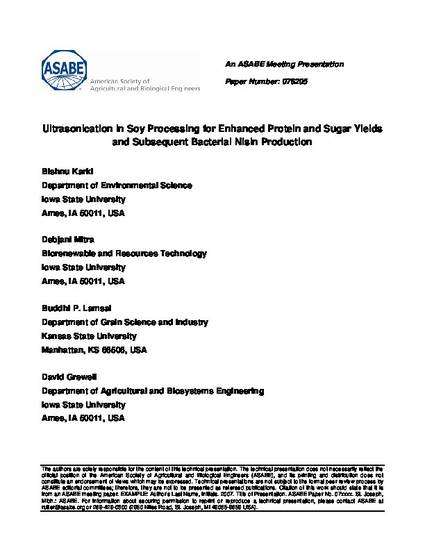
Soy protein recovery from hexane-defatted soybean flakes using conventional methods is generally low. Importantly, some tightly-bound sugar in the soy flakes ends up in soy protein, thereby deteriorating the usefulness and quality of soy protein as a food ingredient. This research investigated the use of high-power ultrasound prior to soy protein extraction to simultaneously enhance protein yield and facilitate more sugar release in soy whey. The nutrient-rich soy whey was then used as a cheap growth medium to produce high-value nisin using Lactococcus lactis subsp. lactis. A nisin sensitive organism Micrococcus luteus was used as an indicator organism for international unit determination of nisin production as compared to standard. Soy flakes and water was mixed at the ratio of 1:10 (w/w). The slurry was then sonicated for 15, 30, 60 and 120 sec at a frequency of 20 kHz. The ultrasonic amplitude was maintained at 84 µmpp (peak to peak amplitude in µm) for all sonication durations. The results showed that with ultrasound pretreatment, the protein yield improved as much as by 46% in soy extract and sugar release by 50% with respect to nonsonicated samples (control). To maximize nisin production from soy whey, different parameters, such as aeration/agitation and incubation period were optimized. Nisin production from standard medium, DeMan, Rogosa and Sharpe (MRS) and soy whey was tested and compared. Maximum nisin production was achieved in stationary conditions and showed a continuous increase in yield till 48h of incubation (incubation period beyond that was not tested). Maximum nisin yield of 1.78 g/L of soy whey was obtained at 30°C and pH of 4.5 as opposed to 2.96 g/L of nisin with MRS medium.
Available at: http://works.bepress.com/david_grewell/6/

This is an ASABE Meeting Presentation, Paper No. 076205.